Although covering a huge area, much of coastal and lowland East Asia is densely populated and rapidly developing, placing enormous pressures on both floodplain and coastal/intertidal wetlands and the wide range of species which they support.
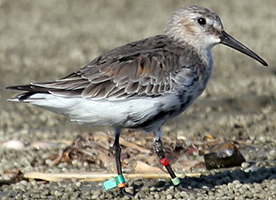
October 6th 2007 © Ju Yong-Gi
Habitat loss and degradation has become so widespread that many species of bird - particularly waterbirds - appear to be undergoing significant declines, with many already threatened with extinction.
Indeed, there are now considered to be more endangered species of waterbird on the East Asian-Australasian Flyway than any other major flyway globally (Parrish, 1994). ("Flyways" are broad corridors used by migrating birds. For wading birds eight Flyways have been defined in the world:
five in Europe and Asia - the East Asian-Australasian, the Central Asia/India, the West Asia/Africa, the Mediterranean/Black Sea and the East Atlantic Flyways - and three in the Americas - the Atlantic, the Mississippi and the Pacific.)
The numbers of waterbirds in the critically-important East Asian-Australasian Flyway are unknown - but there are probably a minimum of 4 million migratory waders alone. The problems of limited public awareness of the importance of this flyway and the biodiversity in it, combined with the lack of resources to effect conservation are further compounded by inadequate data regionally on almost all waterbird populations (overall numbers and trends) or their migrations.
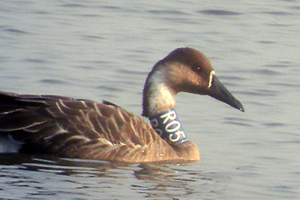
November 8th 2007 © Nial Moores
If better data existed it could be extremely useful in a number of ways: (1) it could allow for the more confident identification of priority sites for conservation; (2) it could enable more focused monitoring of population changes, leading to the development of more effective conservation strategies; and (3) it could help generate awareness (and ultimately) pressure on governments from the local to the national to conserve key sites for global biodiversity.
As elsewhere in the world, data on waterbird populations and their migrations derives mostly from surveys and from banding and flagging initiatives. Surveys are of course essential for identifying key wetlands.
With so many development pressures, the priority in many areas within the flyway still lies simply in identifying internationally important wetlands for waterbirds, wetlands that meet Ramsar waterbird-based criteria by regularly supporting either (1) an assemblage of rare or threatened species; (2) more than 20 000 waterbirds; or (3) 1% or more of a known population of a species of waterbird.
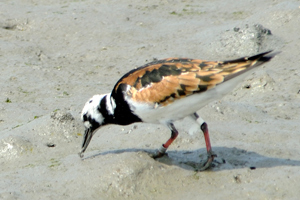
April 18th 2007 © Andreas Kim
Banding and flagging (the marking of birds with small colored plastic tags on their legs or wings), assists this process by allowing for the better identification of migration routes (down to the population level) and the better identification too of wetlands linked by the birds’ often enormous migrations. For some species these wetlands can be located as far apart as Alaska in the north and New Zealand in the south.
National-based data collection and analysis in East Asia has been made more effective through the creation of regional frameworks, such as the Asian Waterbird Census and now increasingly the flyway-wide Asia-Pacific Migratory Waterbird Conservation Strategies (both coordinated by the Wetlands International Asia-Pacific office).
The 5-year Strategies especially have helped to focus limited resources, by dividing waterbirds into three main groups: Anatidae, Cranes and Shorebirds, each with their own flyway officers, working groups and action plans, enabled by funding provided largely by the Australian and the Japanese governments. The working groups have helped to improve networking of concerned specialists and to move towards developing region-wide consensus on species-group conservation strategies.
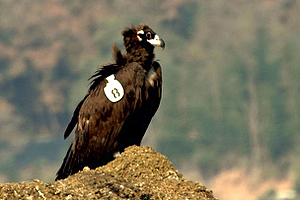
November 24th 2007 Photo © Rich Lindie
They have also assisted in the development of flyway-wide banding activities and flagging protocols. In the case of shorebirds especially (as well as threatened Yellow Sea specialties such as Saunders’s Gull) flagging has been vigorously pursued, as it allows for the participation of more "amateur" or casual birders in flag records and data collection.
Within South Korea, there are still few birdwatchers and even fewer bird researchers, and much bird research has, until rather recently, tended to have a biological- rather than ecological- or conservation-emphasis, meaning consensus on internationally-important wetlands and waterbird migration strategies is still relatively limited.
The first major survey to identify key coastal wetlands for shorebirds was not even conducted until 1988, though this was in fact largely confined to the northwestern Gyeonggi Bay (Long et al, 1988), and many other potentially important areas in the southwest and south especially remained unsurveyed until at least 1998 (Moores, 1999).
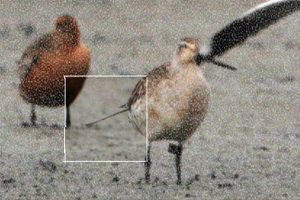
transmitter. Original photo by Jan van de Kam Mid-March 2007
Since the passing of the Wetlands Conservation Act in 1999, however, the Ministry of Environment (MOE) and the Ministry of Maritime Affairs and Fisheries (MOMAF) have become more clearly charged with wetland conservation, and as a consequence are required to conduct regular nationwide surveys of wetlands and their biodiversity. In the case of the MOE and birds, most of this critical survey work has been performed by the Environment Research Institute (ERI), a quasi-government research body (very recently absorbed into the newly-formed Department of Biodiversity: August 2002), which over the past few years has both coordinated efforts for the Strategies and conducted surveys on e.g. wintering waterbirds, passage shorebirds and even on the breeding distribution of egrets. As part of their tremendous workload, the ERI has also been the main body responsible for banding and flagging, and the coordination and dissemination internationally of such records.
With national waterbird surveys in Korea regarded primarily as the responsibility of government and specialists, few mechanisms have yet been put in place to allow for the observations of "ordinary" birders to feed into the growing waterbird and wetland database in Korea. Considering the increasing popularity of birding and the numbers of foreign birders now coming to Korea, much potentially important data is therefore probably being lost. Such data especially e.g. includes observations of Species of Special Conservation Concern as listed in the Strategy (2001), and records of banded or flagged birds.
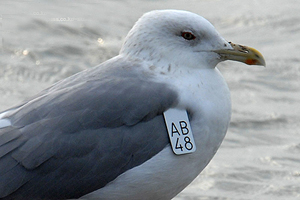
November 11th 2007 © Kim Hyun-Tae
This section of the website therefore aims to help promote flyway banding/flagging initiatives in South Korea, by providing, especially for English speakers: (1) information on regional flag protocols (what colours are being used and where); and (2) by listing key links to responsible bodies. In addition, we offer the website as a place where records of flag sightings can be submitted easily: these can then be forwarded by us as required to the relevant bodies on the observers’ behalf.
Please help us to help save South Korea’s wetlands and birds…if you see any birds flying the flag, mail:
sightings@birdskorea.org.
References:
- Asia-Pacific Migratory Waterbird Conservation Committee. 2001, Asia-Pacific Migratory Waterbird Conservation Strategy: 2001-2005. Wetlands International- Asia Pacific. Kuala Lumpur, Malaysia. 67 pp.
- Long, A., Poole, C., Eldridge, M., Won, P.O., & K.S Lee. 1988. A Survey of Coastal Wetlands and Shorebirds In South Korea, Spring 1988 . Asian Wetland Bureau, Kuala Lumpur.
- Moores, N. 1999. Korean Wetlands Alliance National NGO Wetlands Report. Publ. by Yullinmaul, Seoul.
- Parrish, F. 1994. In Wells, D.R. & T. Mundkur (eds.). 1996. Conservation of Migratory Waterbirds and their Wetland Habitats in the East Asian-Australasian Flyway. Proceedings of an International Workshop, Kushiro, Japan. 28 Nov-3 Dec. 1994. Wetlands International Asia-Pacific, Kuala Lumpur, Publication No. 116, and International Waterfowl and Wetlands Research Bureau-Japan Committee, Tokyo. 304 pp.



